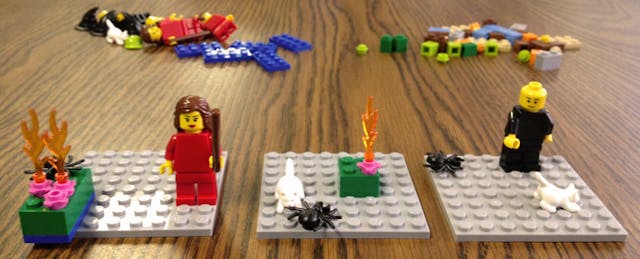One of my fourth grade students displays genius tendencies when it comes to building and tinkering but struggles with engagement during literacy activities. He describes the problem as having too many ideas in his head and not being able to get them out. Pretty self aware for a nine-year-old.
When I mentioned to him that I was going to be meeting with the President of Lego Education at SXSWedu, his eyes lit up. I could tell he was imagining this glowing, Wizard of Oz-style man sitting in a room somewhere building the Legos he dreams of all day in school.
Legos aren’t about talking, they’re about doing—or so I thought. Stephan Turnipseed, president of Lego Education shared about building a robot puppy. It sounded flashy and I was sure I’d want the scoop on how to get a robotics club going at one of the schools I coach in. So it came as a surprise that the most innovative idea I experienced was actually not the robo-pup, but a simple brick kit designed to help students communicate through building.
It's called StoryStarter, and it's a tool for teaching literacy and writing sequences. Think manipulatives for ELA. Turnipseed walked me through the process that teachers are using in their classrooms with StoryStarter.
Each set comes with 1,174 pieces and five plates, each of which are used to show the beginning, middle and end of a story. Students choose from a variety of pieces to develop settings, characters and plots for the stories they tell. They develop their context through building before putting their thoughts and creations into words. For students that struggle with topic generation, there are spinners that can help students get their creative juices flowing. There's also a software program where students can upload photos of their creations and add text.
While the software may heighten engagement for some students, the more innovative element is the idea of using a simple character set with five plates as a sequencing tool to make literacy and storytelling concrete, and incorporating the element of choice for students. It’s really about the pedagogy.
When I brought StoryStarter into the classroom, I worked with a first grader who is a reluctant writer with an untamed imagination. His eyes widened when he heard that he would be working with Legos. He said he had read a book about Legos once but never actually used them.
We began by sorting out the pieces, discussing which pieces were characters and which pieces could be used to develop the setting of our story. Once the pieces were put into categories, and we had tied vocabulary to each brick, it was time to build. His main character: a spider. We planned his story before building it on the plates because he had too many ideas competing for space in his mind. He was able to verbalize his ideas, though he struggled to keep them consistent. The repetitive nature of the plates helped him navigate his story with more clarity.
We built the beginning, middle and end on three plates.
- Beginning: First, the girl tries to hurt the spider with a stick but the spider hides in the grass.
- Middle: Then a cat comes and chases the spider but can’t catch him.
- End: In the end, a boy comes and sends the cat home and the spider is free again.
As expected, the transition from concrete to written story proved more challenging than building the story using Legos. It required intensive modeling, scaffolding and verbal reminders. Ultimately his written work was stronger and more structured than usual and it was clear that with practice and repetition, the written portion would become more natural.
StoryStarter seems best suited for children in grades 1 through 4. Some of the pieces are very small, making them nearly impossible for a student with fine motor weaknesses to manipulate.
There are clear uses with for reluctant writers. Attaching vocabulary to each piece, and using repetitive language to tell a story from beginning to end can help learners make great strides. The tactile nature of the set allows students a risk-free way to share their ideas and get feedback before putting pen to paper. Students who are developing the language skills necessary to be able to tell their story can begin by showing their story, allowing the teacher to provide scaffolded support to match the students needs and abilities.
There is also a great opportunity here for social interaction and growth. In Lego speak, there's an idea called “The Group Build” where individuals can contribute to a larger creation by building a smaller portion. This collaborative method of building has natural layers of differentiation ingrained in it. Students can work in groups of three to build a story or having a larger group put their plates together to create a longer piece of work, considering character development over time—perhaps during a unit on chapter books.
Legos have always been touted as a tool for teaching imagination and creativity, but it's more rare to hear teachers talking about Legos as a tool for teaching storytelling and writing. If Lego comes up with other tools like StoryStarter, that may change.


